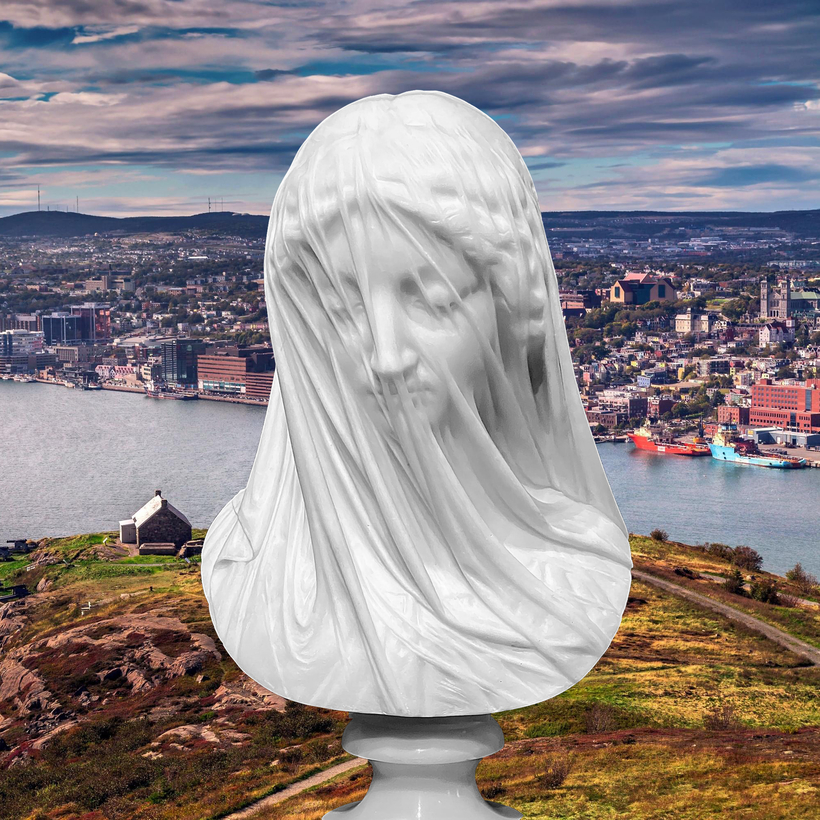For many of us, Newfoundland is best known as a blotch of green on a transatlantic-flight map, reaching out from North America like a fist whose pinky reads, “St. John’s.”
This sparsely populated region of Canada, where majestic cliffs plunge into orca- and iceberg-filled waters, remains remote and mysterious even more than 1,000 years after the Norse explorer Leif Erickson landed there.
St. John’s, its capital city, has a population of just 250,000. In 1901, Guglielmo Marconi, the father of modern communication, received the first transatlantic wireless transmission on Signal Hill, which overlooks the port. Today, bearskins hang on the walls of barbershops, and the statues in St. John’s Harbor do not depict Canadian leaders or British monarchs—Newfoundland was a British colony before joining Canada in 1949—but Labrador and Newfoundland dogs, whose names derive from the area.
Few people know that St. John’s is home to one of the great masterpieces of Western art. Some say Giovanni Strazza’s The Veiled Virgin statue rivals Michelangelo’s Pietà or Auguste Rodin’s Balzac. It’s been hiding in plain sight for almost two centuries in a tiny convent on top of the hill, unbeknownst even to many of its neighbors.
At first glance, the Presentation Convent doesn’t fit the image of the home of a masterpiece, or even a religious order. There are no alabaster walkways or tree-lined courtyards. Instead, it resembles a branch of the Department of Motor Vehicles, a two-story Classical Revival building at the end of an asphalt parking lot, which it shares with a soup kitchen.

The only indication of The Veiled Virgin is a small black-and-white photo of the sculpture, along with its viewing hours. Visitors buzz the door and are seated in a small, austere waiting room. They enter their names in a log while a receptionist goes about her business, answering calls for the convent. Eventually, she opens the doors, and visitors are escorted down a hallway to the oratory on the right.
The lucky ones end up with Sister Marilyn Doyle, the convent’s resident expert on the sculpture, as their tour guide. Instead of a habit and wimple, she wears a wool sweater and sneakers; her Newfoundland accent approximates a soft Irish brogue. Before she joined the order, she obtained a master’s degree in art education and taught in several local schools.
According to Doyle, the sculpture was purchased by Bishop John Mullock, who oversaw the completion of the adjacent Basilica Cathedral of St. John the Baptist in 1855. “The church realized they needed to furnish it, and Mullock traveled to Europe to find relics and objects to fill out the interior,” says Doyle.

Mullock’s travels took him to Rome, where he met with the Pope—“as all bishops did back then,” she explains. When he was in the city, he came across Strazza’s The Veiled Virgin, which he purchased and had shipped to St. John’s.
“Some say he commissioned Strazza to do the work, but I doubt that,” she says. “Looking at the detail, it must have taken a long time, and I don’t think Mullock was sitting around waiting for Strazza to complete it.”
On December 4, 1856, Mullock marked its arrival in his diary: “Received safely from Rome, a beautiful statue of the Blessed Virgin Mary in marble, by Strazza. The face is veiled, and the figure and features are all seen. It is a perfect gem of art.”
The statue remained at Bishop’s Palace next door until 1862, when Doyle says Mullock had a change of heart. “He had a sister who was a nun here at the convent, Sister Mary de Pazzi Mullock,” she says. “The bishop loved her dearly and decided to give it to her and the convent instead. And The Veiled Virgin has been here ever since.”
For over 150 years, says Doyle, the statue remained behind closed doors. “Probably the only people who ever saw it were other nuns and workers who came to service the building,” she says.
In the 1990s, the sisters began to welcome the public. Why the change? “Church policy in general, I’d say,” says Doyle. “The Church decided to open itself up a bit to the world.”
For such a powerful work of art, The Veiled Virgin is remarkably small, a life-size bust in a rectangular glass case on a velvet-covered stand.
Doyle believes that Strazza completed the sculpture in the early 1850s. He’d grown up in Milan and attended its renowned Brera Academy. He was part of the Risorgimento school of Italian nationalist art, whose neoclassical-realist style referenced the work of Renaissance masters such as Michelangelo.
The Veiled Virgin’s face appears to be covered by the semblance of a veil, and yet everything is carved from one piece of Carrara marble. Strazza cut the stone so that light penetrates a few millimeters beneath its surface, allowing the sculpture to give off a glow. The effect is a sort of gossamer transparency, the stone appearing as if it were delicate silk casting thin shadows along the Virgin’s face. The veil seems to dance on the cheeks and chin, caressing the hair and nose, revealing her graceful downward gaze.
According to Claire Barbillon, the director of Paris’s École du Louvre, the technique of veiling—or draping, as it’s sometimes called—was not unique to Strazza. It dates back to 1170, when Notre Dame de Fers (Our Lady of the Shackles) was installed at the Orcival shrine in the Auvergne region of France.
“A contrasting effect stands out,” Barbillon told Radio France in a 2018 interview. “Marble is a hard material which resists chisels and carving, and here it seems to have a flexibility and lightness that creates a paradox.” She says that veiled statues share a few traits: they were created by virtuosos, are extremely rare, and are considered must-sees among art aficionados.
The Veiled Christ, by Giuseppe Sanmartino (1753), is found in the Sansevero Chapel in Naples, where visits must be booked weeks in advance. The Vestal Virgin or Veiled Woman (1743), a sculpture by Antonio Corradini, is located in the Palazzo Barberini, in Rome. Then there’s The Veiled Lady, by Raffaele Monti (1860), which featured in the 2005 adaptation of Pride and Prejudice. (Elizabeth Bennet, played by Keira Knightley, stares at the sculpture, mesmerized.) Monti’s The Veiled Lady is currently held in Chatsworth House, the seat of the Cavendish family, in Derbyshire, England.
During a broadcast on France Culture in 2021, Barbara Musetti, a sculpture historian at the École du Louvre, suggested that The Veiled Virgin distinguishes itself from the other veiled sculptures with its—cover your ears, sisters!—seductive powers.
“These extraordinary effects of the almost wet fabric that adheres to the body create a very strong game of seduction between the character represented and the public,” she said. “There are many other sculptures with similar veiling, especially in the Neapolitan tradition, but none arouses as much enthusiasm, perhaps thanks to this ambivalence between serenity and sensuality, which makes Strazza’s work a masterpiece in the history of sculpture.”
Why such an important work is not promoted by St. John’s or by Newfoundland’s Department of Tourism is anyone’s guess. As of press time, there was no mention of the work on either’s Web site, and Air Mail’s calls to the mayor’s office of St. John’s were not returned.
Many locals are also in the dark. “The veiled who?” said Catherine Ryan, a taxi driver and St. John’s native who attended a Catholic girls’ school right next door to Presentation Convent.
Likewise for Colin, a waiter at the restaurant Rabble. “And believe me, I know a lot of random facts about this place,” he said. Michelle LeBlanc, the proprietor of the Inn by Mallard Cottage in the nearby fishing town of Quidi Vidi, had never heard of Strazza’s masterpiece, either.
The artist, too, is enigmatic. Although two of his other works are well known—Ishmael Abandoned in the Desert, in the Galleria d’Arte Moderna of Milan, and another sculpture in the Vatican—he died in 1875 without enjoying the fame of his contemporaries like Corradini and Sanmartino. One reason may be that Strazza’s style had become dated as Italy moved away from neoclassical towards the futurism movement. It also didn’t help that his greatest work was squirreled away in a convent in Newfoundland.
There’s also a possibility that there’s a missing Strazza out there somewhere. In an 1856 article in The Newfoundlander, The Veiled Virgin is referred to as “the second work by Strazza on the subject of a veiled woman.” Paolo Sabbatini, an art critic and former diplomat, claims that a few of Strazza’s works, including a sculpture of “a veiled damsel,” can be found in the Cairo Marriott Hotel & Omar Khayyam Casino, of all places. (It was previously a royal palace.) According to Sabbatini, Strazza was commissioned to furnish its halls with sculptures by one of the khedives, the viceroy rulers of Egypt from 1805 to 1914.
When I asked Doyle how she thinks The Veiled Virgin holds up in comparison with other veiled masterpieces, she flashed a smile.
“Someone showed me a postcard of another veiled statue. It was of an aristocratic lady, and she had a sort of a crown on her head and the veil was down over it all. And it was truly a beautiful piece. It was. But the Virgin captures something entirely different, and which makes this work unique—it’s simplicity itself.”
For intrepid art aficionados looking to make the Veiled Virgin pilgrimage, St. John’s has an international airport with daily service to Toronto and Montreal.
There’s also the slow-travel alternative, which starts with an overnight train to Halifax from Montreal, followed by a 6-hour drive through Nova Scotia’s Cape Breton to the port of North Sydney, followed by a 16-hour ferry ride and a nearly 2-hour taxi to St. John’s.
That trip takes three days, but it’s an excellent opportunity to meet the locals. My dinner guests aboard the train were impressed when I passed around pictures of The Veiled Virgin as if I were on my way to visit a distant aunt. When, on the ferry, I was tossed left and right in my bunk by the North Atlantic waves, I could appreciate the harrowing trip the statue must have taken back in 1856.
Following our viewing, Doyle and I passed through hallways lined with framed photographs of long-gone nuns who were able to admire The Veiled Virgin every day. I couldn’t help but wonder if my reporting would somehow jeopardize its sanctity and transform the convent into a tourist trap.
Doyle laughed. “We have something that we know is very precious, and if we don’t let people see it, they will never appreciate it,” she says.
Before I left St. John’s, I took a walk up to Signal Hill, where Marconi made history. Radio would soon come, followed by television, the Internet, Jake Paul, Hawk Tuah, and the rage bait and misinformation that now drives our daily lives.
But even during all this doomscrolling, tucked away in a quiet convent a two-minute crow’s flight east from where Marconi stood with his kite, a woman sits in silence. Looking down, her eyes closed and veil drawn, she is ready, once again, to pardon us for our sins.
John von Sothen is a Paris-based writer, a frequent contributor to AIR MAIL, and the author of Monsieur Mediocre


